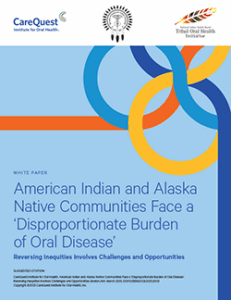Reversing Inequities Involves Challenges and Opportunities
Structural racism and a lack of necessities, such as access to healthy food and adequate housing, have contributed to significant oral health disparities for American Indians and Alaska Natives (AI/AN). While some health outcomes are improving, this white paper ― a collaboration between CareQuest Institute and native-led organizations ― explores the disparities, their causes, and possible solutions. Findings are based on responses from 564 AI/AN participants in the nationally representative State of Oral Health Equity in America survey.
Key points include:
- The prevalence of early childhood caries in AI/AN communities is three times higher than for white children.
- AI/AN adults are twice as likely to have untreated decay as the overall US population, and 83% of AI/AN adults report tooth loss, compared with 66% of the overall US population.
- Three and a half times as many people who identify as AI/AN report going to the emergency department for dental care or mouth pain in the last year (13.5%) compared with those who do not identify as AI/AN (3.9%).
- Researchers and funding organizations need to develop and sustain authentic partnerships with AI/AN communities and organizations to increase representation in research and funding decisions/strategies.
- Culturally driven care and greater AI/AN representation in the dental workforce is needed. The number of AI/AN students applying to dental school has decreased dramatically ― from 92 in 2006 to 19 in 2021.
Solutions to oral health disparities experienced by AI/AN communities, the authors write, must be grounded in diversity, equity, inclusion, and justice. The authors also recommend that accurate data collection regarding the oral health of AI/AN communities must involve clinical examination data, inclusion of AI/AN as an individual category, and the ability to choose more than one racial category in self-reported data to avoid misclassification.
You may also be interested in:
- American Indian and Alaska Native Oral Health: Challenges and Opportunities, in this recorded webinar, a panel of experts discuss findings from the white paper and share ongoing culturally and community-driven strategies — for providers, policymakers, and educators — to improve AI/AN oral health. The webinar is a collaboration between CareQuest Institute and native-led organizations.
- The Glaring Scope of Racial Disparities in Oral Health, a brief that demonstrates the connections between race, ethnicity, and oral health and the implications beyond health.
- Undermining Racism: A Road to Promoting Equity in Oral Health, an article in the Journal of Public Health Dentistry that explains how the Oral Health Progress and Equity Network (OPEN) approaches systemic and institutional racism to address oral health inequities.

